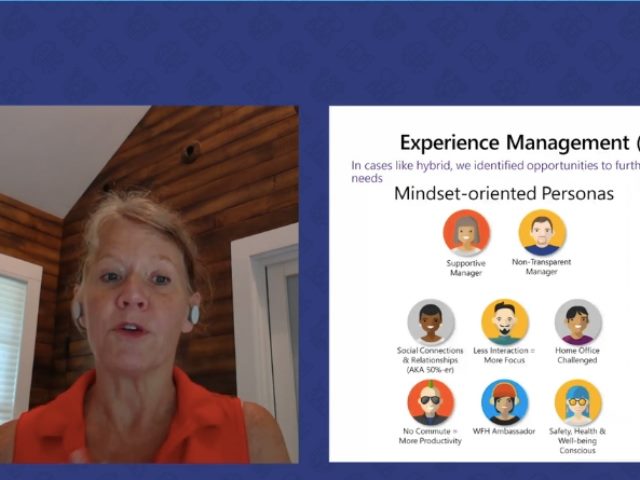

With the shelf life of most skills at about five years and technical skills at around two, most workforce skills will soon be obsolete.
Mike Prokopeak, editor in chief of Reworked.co, shared these thoughts in his opening keynote at the Digital Workplace Experience virtual conference, which aired on July 15. It was the third of four virtual Digital Workplace Experience conferences produced in 2021 by Simpler Media Group, which publishes Reworked.co and CMSWire.com. The themes for the summer event were employee experience, digital literacy and workforce skills.
“Talk about a big challenge,” Prokopeak said of managing employees skills. “The one and only path forward is to work together.”
In that spirit, the event brought together more than 20 speakers from a range of companies, including Microsoft, Liberty Mutual and Morningstar, for a full day of presentations and networking opportunities. Here are some of the takeaways from DWX Round 3.
Editor’s note: All Digital Workplace Experience 2021 sessions are available for free on demand.
The Rise of Capability Academies and Blended Micro- and Macro-learning
Josh Bersin, HR industry analyst and founder of the Josh Bersin Academy, told the audience there is more focus now on skills and development than ever before. Further, he added, about one-quarter of employees switched jobs in 2021, driving new consumption levels of learning and pushing organizations to pursue new ways to of building skills.
What are the most in-demand skills? Oral communication, according to Bersin. Patience, humility, flexibility, listening, caring and the “human skills of work,” he said. Young employees are coming in with a solid technology background but may yearn for those soft skills, or as Bersin calls them “power skills,” which have risen in importance more than ever.
Bersin also discussed the importance of balancing two key types of learning needed in the workplace:
- Micro-learning: For when “I need help now” before quickly returning to work.
- Macro-learning: For when “I need to learn something new.” This may involve getting away from the office to dive deeply into a topic.
“Micro-learning is, I need a video. I need an article. I need to ask a question,” Bersin said. “I want to talk to somebody about something, and I want to go back to the job, because it’ll make me more productive and it’ll help me fix this problem I’m having.”
“Macro is, I’m a bank teller and I would like to be a software engineer. I’m a software engineer, and I’d like to become a cybersecurity specialist. I need some significant education and professional development to move into this new domain, and it’s going to involve some courses, some mentorship, some apprenticeships, some developmental assignments and some trial and error.”
Learning and development leaders have to support each discipline. Bersin pointed to the rise of the “capability academy” as a solution, which is a management structure that resides over learning to foster a coordinated approach to learning and development vs. sending employees off into the wilderness taking one course and expecting them to be prepared and developed.
Related Article: 6 Takeaways From the Spring Digital Workplace Experience Virtual Conference
Employees Bringing Their Whole Selves to Work
The last 15 to 16 months have brought on a great experiment in really understanding each other’s humanity at work, according to Mary Slaughter, global head of employee experience at Morningstar.
“It is really striking that as much as we talked about work-life balance pre-pandemic, there was still a bit of this ‘work is here and life is something else out there,’ and that whole construct just has been blown up,” Slaughter said.
Now, organizations have had to weave those components together in a meaningful way. They’ve had no choice. Employees are bringing emotions to the workplace. That’s OK, because it’s just not reasonable to expect people over an extended period of time to bifurcate their personalities in a hard line between work and home. Because, well, work is at home now for many employees.
“For me, the two biggest shifts are rethinking what we’re listening for and what sentiment … really means,” she said. “And then secondly, (employees) are … bringing their whole self probably to work in the most genuine way ever.”
Define Organizational Pain Points in Employee Experience
Christopher Lind, vice president and chief learning officer for ChenMed, contends that employees pre-pandemic were bringing their whole selves to work, but that they were just trying to compartmentalize it and hide it in different places.
“And it actually made it harder to try and improve things, because you didn’t really know what you were working with,” Lind said. “You were struggling to understand, well, what on Earth is actually creating some of these barriers? Well now we have greater visibility. Now granted, it adds a layer of complexity, but in some ways at least you know what you’re working with where before people were hiding it or compartmentalizing it.”
Measuring employee experience is never-ending and always a moving target, Lind added.
“I think a lot of times people are looking for what’s the top five metrics you can track to be measuring employee experience, and, really, does it exist?” Lind asked. “Because you have to understand what is the need of the organization. Where are the pain points? How do employees feel about being an employee in your organization? What are the biggest impacts and inhibitors to that?”
Once you arrive at those data points, measure whether you’re making progress toward those pain points.
Related Article: 10 Takeaways from the Winter 2021 Digital Workplace Experience Conference
Onboarding: Shifting Away from an ‘HR Thing’
Chip Houghton, vice president and senior director of global performance and talent practices at Liberty Mutual Insurance, said companies traditionally viewed onboarding as mostly focused on new hire orientation: getting together in a location with the HR team, talking about benefits and gathering necessary HR information.
Fast forward a little bit to his company’s next part of the onboarding journey. There’s a new HR service delivery model, which means a little more self-service for managers and less in-person time, but it was still focused on HR-related material.
Now, with new onboarding technology, the company has a much bigger focus on employee experience. “So moving away from policy/compliance kinds of things to what’s the experience like for employees,” Houghton said. “Let’s try to have a holistic consolidated common approach to bring people into the company with more focus on experience and an introduction to our culture and values.”
The goal is to make new employees feel included and a part of the organization in a much bigger and broader way. It’s a personalized model that intends to build a strong connection with the employee at the outset.
“We recognize that (the first 60 to 90 days) is such a critical time period to make sure that experience is positive, that we can convince people that decision to come to work for Liberty Mutual is the right one,” Houghton said. “And that they have a future with us.”
Remote Work: Can’t Go Back to Old Workplace Habits
Laurel Farrer, CEO of Distribute Consulting, noted that 86 percent of the workforce pre-COVID wanted to work remotely or wanted more flexibility in their workplace model. And conveniently, that is pretty much the same statistic that we are seeing post COVID, Farrer added.
“So the demand and the interest in remote work hasn’t changed,” she said. “What has changed since then is the leadership support. Because there’s no excuses anymore. Before there was a strong narrative of that’s not possible or that wouldn’t work for us or that wouldn’t work for you. Maybe some exceptions could be made, but it was just so uncommon. Only 3 percent of the United States workforce worked full-time remote. Now that excuse is gone.”
Organizations need to continue to embrace the future of work and create a new dynamic of human empowerment in the business world, she said. Farrer noted in the past discrimination between the people that worked on site, and those that were out of the office.
“So how do we overcome that?” she asked. ”We can’t go back to business as usual because business as usual is based on decades and decades and generations of business based on the assumption that people are working in a physical co-located environment. This has been happening since the Industrial Revolution. So it’s all that we know.
“What we have to do is break that mindset completely and do a lot of unlearning on tracking and reporting productivity, managing and supporting from a distance. We have to really learn what it means to be a team and to collaborate together in a way that isn’t based on time or location.”
Hybrid teams should not be “some people are in the office and some people are out of the office,” she said. It should be a concept of all employees operating the same way regardless of where workers are located.
Employees Need Career Options
Beverly Kaye, author and CEO of BevKaye & Co, said one of the best ways to connect with employees is to build the connection with their career desires. There are a number of career-related questions employees have on their minds.
Organizations also need to be mindful of giving employees ongoing feedback, so they know how they can improve. They need to be kept in the loop on how the organization is changing and make sure there are options within it for them to grow.
“Very few organizations offered the tools to help the employee take charge,” Kaye said, “and now I think that’s changing. And I think our COVID experience has gotten more people to realize it’s my responsibility. And I’m going back in there, and I am going to ask for what I want. And I am going to say here’s what I learned during my time being remote.”
How Microsoft Approaches Employee Experience Management
One of the ways that Microsoft creates strong employee experiences is by listening to what employees say in employee focus groups.
Karen Kocher, global general manager, talent and learning experiences and workforce of the future at Microsoft, capped off the day with an inside look at how the Redmond, Wash.-based software giant systematically builds employee experiences through personas and profiles. She said the focus groups are part of an agile development process that Microsoft uses to put its aspirations and mission into action at scale.
“They can then give us insights into what that means to them, how they interact with that, and that usually sheds enough light on it that we can decide to pull from the portfolio that we have,” Kocher said. “But even if we agree we need to create something new, … what is a priority? We have so many priorities that is this really a high priority? And again, what is really valuable is that employee feedback.”






